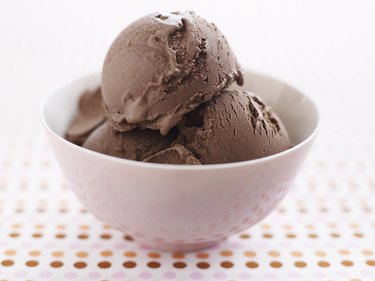
Slow-digesting foods are typically those that are high in fiber, protein and fats. Your body takes longer to digest fat and protein. These are components of milk and cream, which makes ice cream digestion time slower.
Tip
Ice cream digests slowly because of the fat and protein it contains.
Video of the Day
Rate of Digestion of Foods
Digestion begins in your mouth when you chew your food. Chewing physically breaks the food down into smaller particles before it enters your digestive tract. Your saliva also contains enzymes that begin to chemically break down the food. Ice cream doesn't require any chewing, so this stage is over quite quickly.
Video of the Day
Once you swallow your ice cream, it travels through your esophagus to your stomach, where it mixes with acids and enzymes, including pepsin, hydrochloric acid, gastric lipase and intrinsic factor, according to the Colorado State University. From there it moves to your small intestine, where digestive juices from the liver, pancreas and intestine continue to break it down, explains the National Institutes of Health.
Not all foods are broken down at the same rate. Simple carbohydrates, such as sugar and refined grains, are digested quite quickly. They are broken down into glucose, which is then sent into your blood stream to travel around your body. Complex carbohydrates that are higher in fiber, protein and fats are broken down more slowly and stay in the stomach for a longer period of time.
Ice cream digestion time is slowed because of the milk digestion time. A scoop of plain vanilla ice cream contains 7 grams of fat and 2 grams of protein, according to USDA data. A scoop of chocolate ice cream contains a similar amount of fat and protein — 7 grams and 3 grams, respectively.
Some types of ice cream may have considerably more fat and protein. A rich vanilla ice cream contains 17 grams of fat and 4 grams of protein per scoop. One variety of ice cream that contains peanut butter ripple, peanut butter cups and peanut flour has 17 grams of fat and 6 grams of protein. Nuts are high in both protein and fat, so ice creams containing them will be higher in both macronutrients and therefore digest more slowly.
Why Digestion Rate Matters
All food gets digested eventually, so why does it matter? There are two main reasons:
It affects your blood sugar: Foods that digest quickly — simple carbohydrates — cause glucose to flood the bloodstream. This causes a surge in energy that is quickly followed by a drop in energy when the glucose is depleted, leading to fatigue, explains the American Heart Association.
It affects your appetite: Slow-digesting foods stay in your stomach longer, which keeps you feeling fuller for longer. Gastric distension, when your stomach expands after eating, signals to the brain that you are full and satiated. Stomach distension also inhibits the release of a hormone called ghrelin, which stimulates the appetite, according to a review article published in the Journal of Nutrition and Metabolism in January 2019.
In general, choosing foods that digest slowly is better for your overall health and energy levels as well as weight management.
However, just because a food takes longer to digest, that doesn't mean you should eat it — or at least not a lot of it. Ice cream is rich in saturated fat, which is found in all animal foods. According to the American Heart Association, this type of fat raises cholesterol levels and increases your risk of heart disease and stroke.
Ice cream is also high in sugar, the simplest carbohydrate of all. The fat and protein may slow the digestion, but sugar — especially added sugar — is bad for your health. Excess consumption of added sugar leads to weight gain and obesity, which are major risk factors for cardiovascular disease and type 2 diabetes, warns the Centers for Disease Control and Prevention.
Combine that with the high fat content of ice cream, and you've got a calorie bomb that is sure to increase your waistline, regardless of how fast or slow it is digested.
- USDA FoodData Central: "Ice Creams, Vanilla"
- USDA FoodData Central: "Ice Creams, Chocolate"
- USDA FoodData Central: "Ice Cream"
- Colorado State University: "Gastric Secretions"
- National Institutes of Health: "Your Digestive System & How it Works"
- USDA FoodData Central: "Ice Creams, Vanilla, Rich"
- American Heart Association: "Carbohydrates"
- Journal of Nutrition and Metabolism: "The Role of Fiber in Energy Balance"
- American Heart Association: "Saturated Fat"
- Centers for Disease Control and Prevention: "Know Your Limit for Added Sugars"


